
Michał Kaczmarzyk, CEO of Warsaw Chopin Airport, General Director of Polish Airports State Enterprise: “Together, the two Warsaw airports will have handled about 13.5 million passengers by the end of this year meaning Warsaw is the largest aviation market in this part of Europe. Our company – Polish Airports State Enterprise – also has a 30% share in Modlin so we’re totally involved with the differing markets served by the two airports.”
The rising prosperity of Polish society is fuelling a solid and consistent increase in air travel, which is forecast to grow by an annual 5-8% over the next 20 years, according to Michał Kaczmarzyk, CEO of Warsaw Chopin Airport, General Director of Polish Airports State Enterprise. He told Ross Falconer how Poland’s airports are capitalising on this above-industry average, healthy trend.
Despite the constant increase in the mobility of Polish citizens, air travel still remains at a relatively low per capita level in the country. While in Germany or France every citizen takes an average of 2.5 flights per year, in Poland the average is just 0.7 trips. However, Poland’s Civil Aviation Authority forecasts by the end of this decade this will rise to 38 million flights – equivalent to one for every Pole – rising a further 70% to 65 million by 2030.
Other EU countries may cast an envious glance at a Polish growth rate which is also confirmed by the experiences at the Polish regional airports: Virtually all have experienced record increases this year, with the results of Lublin (+95% year-on-year), Modlin (+40%) and Katowice (+14%) standing out.
“Robust development of air transport in Poland is not going to slow any time soon,” said Michał Kaczmarzyk, CEO of Warsaw Chopin Airport, General Director of Polish Airports State Enterprise, who was appointed in February 2014, and the statistics for Polish Airports’ core asset, Warsaw Chopin Airport, are certainly positive. Warsaw Chopin handles over 40% of Poland’s total air traffic; October was the 13th consecutive record month, and over 11 million passengers are expected for 2015 as a whole while it served 9.7 million in the first 10 months of the year (+6.3%).
“While looking at Warsaw, and comparing it to other airports in the region such as Prague or Budapest, one has to take into account the fact that Warsaw has two airports – the main airport Chopin, and the recently-opened Modlin which is dedicated to low-cost carriers,” Kaczmarzyk noted. “Together, the two Warsaw airports will have handled about 13.5 million passengers by the end of this year meaning Warsaw is the largest aviation market in this part of Europe. Our company – Polish Airports State Enterprise – also has a 30% share in Modlin so we’re totally involved with the differing markets served by the two airports.”
There is perhaps no clearer symbol of industry health and growth in Poland than the recently-opened new terminal at Warsaw Chopin, which has boosted the airport’s capacity to over 20 million – a figure it is likely to reach within seven years, underpinning a key element in Kaczmarzyk’s strategy to develop “the most important and the largest airport in Central Europe”.
New terminal: Completely new world
“The new 60,000sqm terminal is a completely new world, providing new sensations and new opportunities to generate non-aeronautical revenues, including 15 new stores and 10 bars and restaurants spread across 3,000sqm of new commercial space,” enthused Kaczmarzyk.
Over the past year, the proportion of overall revenues at Warsaw Chopin generated through non-aeronautical activities has grown from 25% to 30%. “In line with the global trend in our industry, we are working to further increase this share,” Kaczmarzyk explained. “The prospects are promising. Now, after only a few months of operation, it brings more revenue than before the refurbishment. We’re not stopping there, we also have other new ideas and initiatives to increase our revenues and excite and engage our customers.”
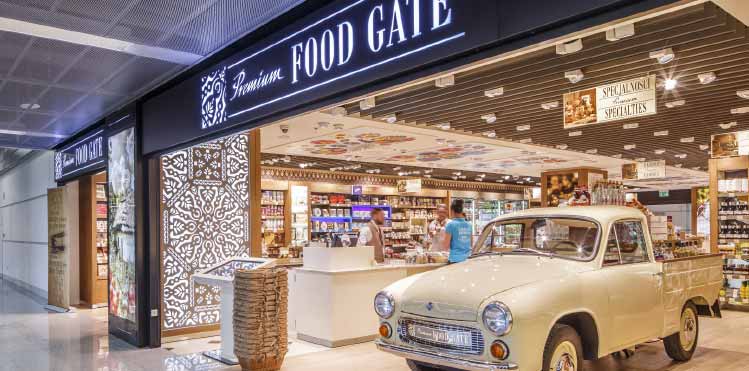
The new 60,000sqm terminal at Warsaw Chopin provides new opportunities to generate non-aeronautical revenues, with 15 new stores and 10 bars and restaurants spread across 3,000sqm of commercial space.
One such idea is Chopin Airport City – an office and retail complex planned adjacent to the airport. A specially-dedicated entity – Chopin Airport Development Company – has been established to develop a detailed concept with a timetable for implementation of the project, and to obtain the go-ahead needed for such an ambitious development.
Other change is firmly focused on enhancing the passenger experience. New gate readers have been installed at Warsaw Chopin for automated boarding pass control, while the airport also plans to utilise beacon technology to help passengers navigate through the airport through a Bluetooth connection on their smartphones. “The works are at a very advanced stage and I think that soon we will be able to boast one of the most innovative networks of its kind across Europe,” Kaczmarzyk added.
Warsaw Chopin is also committed to environmental innovation and is accredited at the ‘Mapping’ level of ACI’s Airport Carbon Accreditation. The airport is now aiming for the ‘Reduction’ level of the programme. The new terminal includes 7,000sqm of roof-mounted solar panels – the largest power plant of its kind in Poland. This allows production of about 100 megawatt-hours of electricity per year. “On sunny days, the panels provide up to 25% of demand for energy in the terminal,” Kaczmarzyk said. “We are also thinking about the next initiatives to reduce our carbon footprint. In the case of the regional airports in Poland, they are also interested in applying to become Airport Carbon Accredited. We really feel our responsibility for the environment; it’s core to our business.”
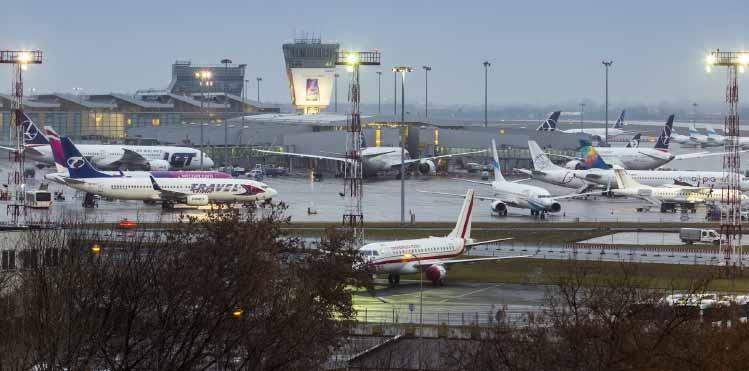
There is a clear focus on attracting new airlines and new long-haul routes to Warsaw Chopin to enhance its position as a regional transfer hub. A range of tremendously important new routes starting next year include LOT direct services to Tokyo, Bangkok and Seoul.
Warsaw Chopin: A regional transfer hub
LOT Polish Airlines is, of course, Warsaw’s biggest carrier with 40% of traffic. Accordingly it enjoys the brand new privilege of a dedicated area of the terminal – the LOT Warsaw Hub – which launched in October, providing an exclusive check-in area for all LOT passengers, which minimises the distance from terminal entrance to departure gate. LOT is followed by Wizz Air – which significantly does not have operations at Modlin – with a 14% market share.
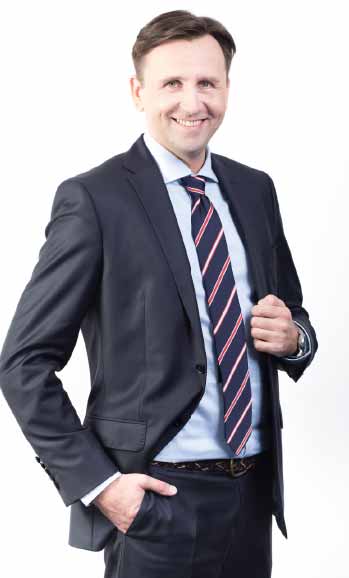
Michał Kaczmarzyk, CEO of Warsaw Chopin Airport, General Director of Polish Airports State Enterprise: “For the development of long-haul connections, the attractive geographical location of Warsaw in the heart of Central Europe is of great importance. Warsaw Chopin Airport now serves as a regional hub for passengers from neighbouring countries.”
Kaczmarzyk articulates a clear focus on attracting new airlines and new long-haul routes to Warsaw Chopin to enhance its position as a regional transfer hub.
A range of tremendously important new routes starting next year include LOT direct services to Tokyo, Bangkok and Seoul, while Air Canada will launch its first-ever Warsaw service – from Toronto.
“Of course the attractiveness of the airport to consumers is dependent on the choice of the carriers which operate there,” Kaczmarzyk said. “Therefore the new long-haul connections are also a catalyst for increasing traffic on the Warsaw hub’s connecting services. We welcome any announcement of a new connection and we hope to get even more. We work hard to convince airlines to consider Warsaw as their destination, and we’re really pleased with the recent results of our efforts. We already have four carriers operating intercontinental routes and we hope to gain more.”
Emirates recently introduced a larger aircraft on its Dubai service (upgrading to 777 instead of A330) and is also reported to be considering a second daily flight. Qatar Airways is also considering upgrading from an A320 to its new showcase 787 on its Warsaw services. “LOT is also excited to be getting its seventh Dreamliner allowing it to open new viable routes to Asia and America which all shows faith in the potential of our airport and market,” Kaczmarzyk added.
A variety of incentives are offered to new full service and low-cost carriers looking to operate from Warsaw Chopin. For example, any carrier launching a new long-haul connection from Warsaw receives a 99% discount on airport charges for the first two years of operation, and partnership assistance with marketing campaigns.
A key strategic focus is increasing transit traffic, which currently accounts for 20% of the total, with the aim to increase that share to at least 50% over the next five years. “We will achieve this goal primarily with our main partner, LOT, but the effects of this are also beneficial for other carriers,” Kaczmarzyk commented. “For the development of long-haul connections, the attractive geographical location of Warsaw in the heart of Central Europe is of great importance. Warsaw Chopin Airport now serves as a regional hub for passengers from neighbouring countries such as Belarus, Ukraine, Hungary, Romania, Slovakia and Serbia. And thanks to the development of an attractive air connection network, this role will continue to grow in importance.”
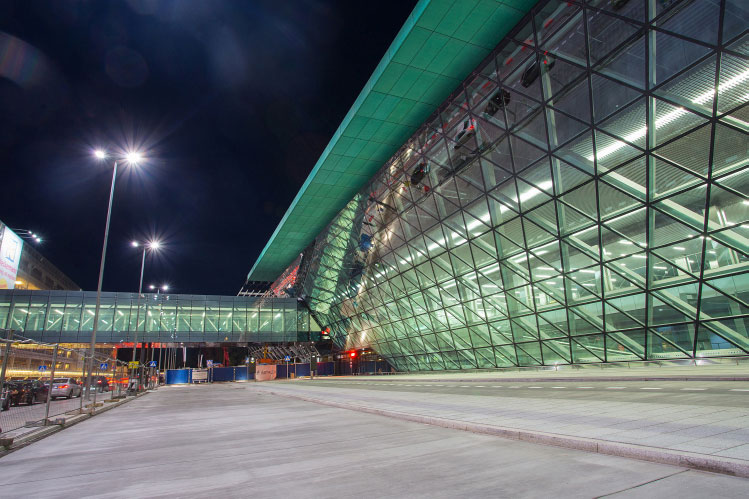
At Kraków, €120 million has been invested in an extensive modernisation including extension of the passenger terminal, new taxiways and apron expansion.
Polish regional airports “enjoy investment boom”
Following a successful restructuring last year the workforce at Warsaw Chopin was slimmed down by 35% from 2,200 to 1,400. The resultant reduction in operating costs means that Warsaw Chopin is now, according to Kaczmarzyk, one of the most profitable airports in Europe. Record financial results of Polish Airports State Enterprise (an EBITDA margin above 40%) are now allowing it to think about investing outside Warsaw; and indeed the Polish regional airports are developing rapidly.
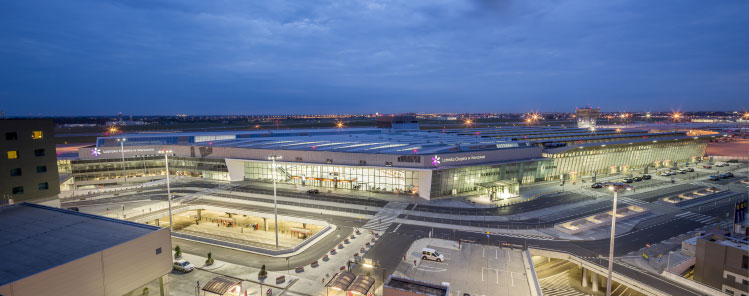
There is perhaps no clearer symbol of industry health and growth in Poland than the recently-opened new terminal at Warsaw Chopin, which has boosted the airport’s capacity to over 20 million.
Kraków: €120 million
At Kraków, €120 million has been invested in an extensive modernisation including extension of the passenger terminal, new taxiways and apron expansion. The next phase will see renovation of the existing terminal which, once complete, will provide a capacity of eight million passengers (about double current throughput).
Katowice: €100 million
Katowice, which served a record 2.7 million passengers in 2014 and expects to handle over three million this year, is also undergoing the biggest investment programme in its history, totalling €100 million. A new 3,200m runway opened in May, which enables Katowice to handle widebodies, and a new arrivals terminal has also been completed. Other projects underway include construction of a de-icing ramp, while there are plans to develop the airport’s cargo infrastructure, with a new cargo terminal and a dedicated apron due to be ready by the end of May 2016.
Gdańsk Lech Wałęsa: +€15 million
Development projects worth over €15 million have recently been undertaken at Gdańsk Lech Wałęsa Airport. Terminal 2 has been extended by about 30%. The airport has renovated the runway and installed Cat II ILS, and a new rail connection between the airport and the centre of Gdańsk opened in September.
Meanwhile, Poznan and Bydgoszcz airports underwent runway repairs this autumn, and Szczecin Airport has resurfaced its runway and completed apron and taxiway works.
Even Zielona Góra-Babimost – Poland’s smallest airport, which handled about 12,000 passengers in 2014 – opened a new arrivals hall in September, with the existing facility adapted to exclusively handle departing passengers.
Looking ahead, there will also be a focus on additional investment in Modlin Airport. Three years after it opened Modlin Airport handles nearly 2.5 million passengers a year and is approaching the limits of its capacity. Expansion of the terminal and a new apron are urgently needed. “The other shareholders unfortunately are not eager to finance these works and it may halt the development of this airport. We could do it. I must admit that I would willingly take over a majority stake in Modlin and create a ‘duo-port’ handling passengers for the central Polish market,” said Kaczmarzyk, who also significantly asserted that PPL could even invest outside of Poland: “We also have the funds for potential acquisitions and equity investments and analyse opportunities on the international market – I think it’s a good time to launch the ‘Polish Airports’ activities in Europe. According to forecasts, Poland’s air traffic will reach 65 million by 2030. We need to start planning now to accommodate the next generation of growth.”
About Polish Airports State Enterprise
“Polish Airports” manages two airports: Warsaw Chopin and Zielona Góra-Babimost. It also has stakes in nine companies, supervising the operation of airports in Kraków (76.19% stake), Szczecin (47.19%), Rzeszow (47.04%), Poznan (40.52%), Modlin (30.39%), Gdansk (29.09%), Wroclaw (19.74%), Katowice (16.41%), and Bydgoszcz (8.06%).
PPL also holds 100% of shares in Welcome Airport Services (ground handling company) and Chopin Airport Development Company (hotels and real estate development).
Warsaw Chopin Airport factbox
2014: 10.5 million passengers
2015 (Jan-Oct): 9.7 million passengers
2015 passenger traffic growth (Jan-Oct): 6.3%
Key airline customers: LOT Polish Airlines, Wizz Air, Lufthansa
Number of routes: 80
Top 3 destinations: London, Paris, Frankfurt
Michał Kaczmarzyk biography
Michał Kaczmarzyk is a graduate of the Global ACI-ICAO Airport Management Professional Accreditation Programme (AMPAP); Concordia University, Montreal; Faculty of Economics, Radom University of Technology, as well as Warsaw School of Economics.
Kaczmarzyk’s career has spanned PricewaterhouseCoopers, Poland’s Industrial Development Agency, and the Office of Competition and Consumer Protection. In November 2010 he took over as CEO of LOT Cargo S.A. and later as CEO of LS Airport Services S.A.
In February 2014, Kaczmarzyk was appointed General Director of Polish Airports State Enterprise and CEO of Warsaw Chopin Airport.
Kaczmarzyk (36) is married and has two sons.







